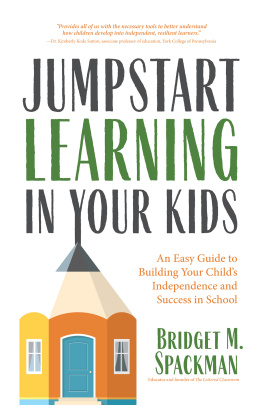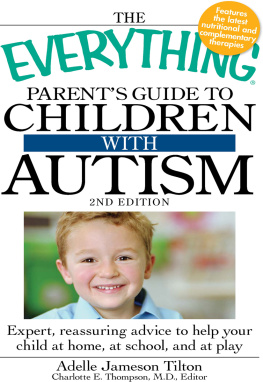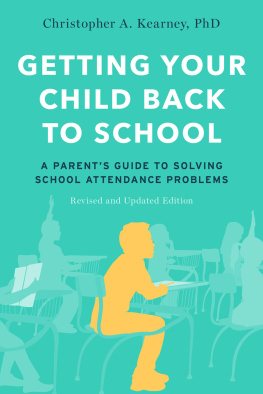Copyright 1989 by Gene I. Maeroff
ACKNOWLEDGMENTS
Grateful acknowledgment is made to the following for permission to reprint previously published material:
American Library Association: Excerpt from Notable Childrens Books 1987. Reprinted with permission of the American Library Association.
Association of American Geographers: Excerpt from Guidelines for Geographic Education: Elementary and Secondary Schools.
Susan Becker: Excerpt from Helping Parents Choose Wisely, from Instructor, 1986.
CTB/McGraw-Hill: Excerpt from California Achievement Tests, Forms E and F, Class Management Guide. Copyright 1986 by McGraw-Hill. Reprinted with permission of CTB/McGraw-Hill.
Reo Christenson: List of Values and Attitudes.
The College Board: Excerpt from Degrees of Reading PowerTest Booklet Form PX-1.
Edgell Communications: Excerpt from What Is Hands-On Science? from Instructor. Reprinted with permission of Edgell Communications.
Evanston Educators: Excerpt from Family Software Catalogue.
The Executive Educator: Excerpt from The Essentials for Reading Programs by Nicholas P. Criscuolo. Reprinted with permission of The Executive Educator, March. Copyright 1986. All rights reserved.
International Business Machines Corporation: Excerpt from Child Care Handbook. Copyright 1984 by International Business Machines Corporation. Reprinted with permission of International Business Machines Corporation.
Missouri Department of Elementary and Secondary Education: Excerpt from How Does Your Child Grow and Learn? A Guide for Parents of Young Children, revised edition, 1982.
H. L. Mountzoures: At the Tutors from The New Yorker, June 16, 1986. Reprinted by permission of the author.
National Association for the Education of Young Children: Excerpts from Toys: Tools for Learning and Helping Children Learn About Reading by Judith A. Schickedanz.
National Association of Secondary School Principals: Excerpt from Teaching Thinking from Curriculum Report, 1986.
National Committee for Citizens in Education: Excerpt from Your School: How Well Is It Working? 1982.
National Council of Teachers of Mathematics: Excerpt from Curriculum and Evaluation Standards for School Mathematics, Working Draft.
Nebraska Department of Education: Excerpt from The Position Paper on Kindergarten.
Mike Olenick: Excerpt from What Is Quality Child Care?, a speech to Los Angeles County League of Women Voters, June 7, 1986.
Phi Delta Kappan: Excerpts from Computers in Education TodayAnd Some Possible Futures by Alfred Bork; Evaluating Educational Software by Gail Caissy; Junior First Grade by M. R. Solem.
Reading Is Fundamental, Inc.: Excerpt from When We Were Young. Copyright 1987 by Reading Is Fundamental, Inc. Used by permission.
Allan Shedlin, Jr.: Excerpt from New Lenses for Viewing Elementary Schools.
Totowa (N.J.) Board of Education: Adapted excerpt from New Jersey Test of Reasoning Skill.
World Book, Inc.: Excerpt adapted from Getting Ready for School. Copyright 1987 by World Book, Inc.
PREFACE
Until the late 1970s it was assumed in America that children would always exceed the accomplishments of their parents. Upward mobility was an article of faith held with every bit as much assurance as the belief that the sun would rise each morning. And, for the most part, children did exceed their parents. Then something happened. People began to realize they were dancing to a tune that had stopped playing.
Inflation struck, and homes that had always cost about the same relatively low price skyrocketed in value. Cokes and candy bars that had sold for a nickel started pushing toward the dollar mark. The prices of items that had been cheap and abundantgasoline and heating oil, for examplezoomed as scarcities developed. Jobs that had always awaited college graduates became subject to intense competition. Teenagers in affluent suburbs realized they might not be able to afford to live as adults in the communities in which they were growing up.
Pressures were intensified by a climate in which American workers found their companies dying in the face of foreign competition. An industrial stalwart like General Motors saw its share of the automobile market forced to a low point in the mid-1980s. Three of the four companies that made Akron, Ohio, the tire capital of the world virtually gave up the business. An entire new industry based on the videocassette recorder came into full bloom, with all 12 million sets that were sold each year in the United States manufactured abroad.
More than ever, the need has been underscored for a sound education that equips one to cope with a changing world. Success depends on a lot more than doing well in elementary school, but surely elementary school is the foundation for all that follows in formal education. Students who do poorly in elementary school enter secondary school at risk and there is a good chance that they will take that disadvantage with them when they reach collegeif they get that far.
The school-reform movement that swept through Americas classrooms during the 1980s blew away some cobwebs and improved some practices. Elementary education, though, remained essentially unchanged during the 1980s; there are still few provisions to ensure that the system provides a safety net for children whose parents dont look out for them.
This is not to say that teachers and principals and school board members and lawmakers are uncaring. They often do what they can to protect the interests of schoolchildren. But with 45 million kids in school there is just so much that even the most responsive and humane system can do for each child.
Thus, parents who step into the breach and try to learn enough about elementary education to become helpers and advocates for their children can make a marvelous contribution. This book is useful for any parent serious about taking this step, whether the child attends public or private school. It is no less valuable for someone who simply wants to be better informed about the workings of elementary schools.
After about a quarter of a century as a specialist writing about education throughout the country, I have found that this book has allowed me to tap into a wealth of observations. I am indebted to the many experts whom I have interviewed over the years and, in particular, to those who have made time available specifically to discuss aspects of the topics covered in this book. I offer my appreciation in this regard to Richard Anderson, John Chaffee, Jeanne Chall, Bob Davies, Roger Farr, Shirley Brice Heath, Barbara Nuding, Catherine Snow, Bill Ward, Mel Wasserman, and Burton White.












